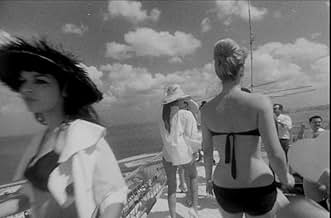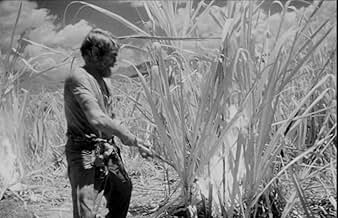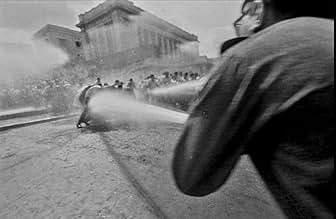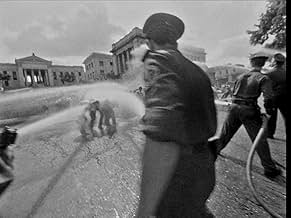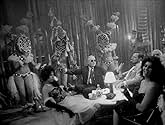Soy Cuba
- 1964
- Tous publics
- 2h 21m
IMDb RATING
8.2/10
12K
YOUR RATING
Four vignettes about the lives of the Cuban people set during the pre-revolutionary era.Four vignettes about the lives of the Cuban people set during the pre-revolutionary era.Four vignettes about the lives of the Cuban people set during the pre-revolutionary era.
- Director
- Writers
- Stars
- Awards
- 2 wins & 1 nomination total
Mario González Broche
- Pablo
- (as Mario González)
- Director
- Writers
- All cast & crew
- Production, box office & more at IMDbPro
Featured reviews
No less than thirty shots have been ripped off from this movie in the past five years, in films like Out of Sight, Boogie Nights, and Pulp Fiction. Watching "I Am Cuba" is an education in film technique and the beauty of the eponymous country. The picture's plot is abysmal. It is an exercise in cinematography. It is among the most influential movies, style-wise, that the American public has never seen and honestly brilliant on all terms.
Imagine taking a tour of Cuba, in 1964, through the eyes of four metaphors: luxury, poverty, revolution, and vagrancy. Times are changing, the country is changing. However, no matter how much anything changes, the sun-soaked gorgeousness of the land doesn't budge. The camera glides around like a member of the tour who has gone off on his own, looking at the four principles.
I Am Cuba is film that needs no hyperbole. It Is Great
Imagine taking a tour of Cuba, in 1964, through the eyes of four metaphors: luxury, poverty, revolution, and vagrancy. Times are changing, the country is changing. However, no matter how much anything changes, the sun-soaked gorgeousness of the land doesn't budge. The camera glides around like a member of the tour who has gone off on his own, looking at the four principles.
I Am Cuba is film that needs no hyperbole. It Is Great
I am Cuba/Soy Cuba features the stories of several Cuban citizen-types: a young prostitute, a farmer, a young revolutionary and so on, up to the start of the island's Castro Revolution.
If this sounds dull, then rest assured that the plot is minimal and, despite it's avowedly political purpose, hardly gets in the way of the film's main attractions today. What distinguishes the production is the cinematography. It is not an exaggeration to say that the images and technique in the film are breathtaking, and it is a tour-de-force of bravura camera work. Apparently Martin Scorcese has screened this film privately to work out how such-and-such a shot was achieved, and perhaps it's influence can be found in the famous through-the-kitchens tracking shot in 'Goodfellas'.
This is a film where the camera is constantly in motion, with sweeping balletic long takes, crane and hand held shots, tracking shots, including some over and down the side of buildings, through cane fields, into swimming pools, around packed night clubs, even hovering and moving along high over a street in the middle of a packed funeral procession - all without the usual cutting. I estimate the average length of a take in this film at about 2 - 3 minutes, a figure rare and astonishing these days, even with the benefit of steadicams - but jaw dropping given the still-unwieldy equipment they were surely using in 1964. In particular one or two large scale sequences must have taken days, if not weeks, to prepare, and presumably needed government marshaling to choreograph. (Ironically, whether or not the film makers intended it, the liberated camera work on display here reflects the notion of revolutionary freedom far more than the actual story vignettes.)
The film itself is shot in high contrast gleaming black and white, favouring wide angle lenses, and with a constant deep focus that reminded me of Greg Toland's work for Welles or some of James Wong Howes' work. Kalatozov's use of a handful of character 'types' throughout recalls Eisenstein's (and in fact there is a faint reference to his the Odessa Steps sequence in 'Battleship Potemkin' at one point when the revolutionary rioters march down some steps), but the effect here is far more sensual and lyrical. (Among the professional actors, Sergio Corrieri also appears in the better-known Memories of Underdevelopment). The film's 'artiness' is undeniably a distraction from the message of struggle, and to the original viewers the beautiful images must have been a long way from reality in the New Cuba.
Today we don't have this problem and the viewer is left with a visual feast to enjoy over and over again..
If this sounds dull, then rest assured that the plot is minimal and, despite it's avowedly political purpose, hardly gets in the way of the film's main attractions today. What distinguishes the production is the cinematography. It is not an exaggeration to say that the images and technique in the film are breathtaking, and it is a tour-de-force of bravura camera work. Apparently Martin Scorcese has screened this film privately to work out how such-and-such a shot was achieved, and perhaps it's influence can be found in the famous through-the-kitchens tracking shot in 'Goodfellas'.
This is a film where the camera is constantly in motion, with sweeping balletic long takes, crane and hand held shots, tracking shots, including some over and down the side of buildings, through cane fields, into swimming pools, around packed night clubs, even hovering and moving along high over a street in the middle of a packed funeral procession - all without the usual cutting. I estimate the average length of a take in this film at about 2 - 3 minutes, a figure rare and astonishing these days, even with the benefit of steadicams - but jaw dropping given the still-unwieldy equipment they were surely using in 1964. In particular one or two large scale sequences must have taken days, if not weeks, to prepare, and presumably needed government marshaling to choreograph. (Ironically, whether or not the film makers intended it, the liberated camera work on display here reflects the notion of revolutionary freedom far more than the actual story vignettes.)
The film itself is shot in high contrast gleaming black and white, favouring wide angle lenses, and with a constant deep focus that reminded me of Greg Toland's work for Welles or some of James Wong Howes' work. Kalatozov's use of a handful of character 'types' throughout recalls Eisenstein's (and in fact there is a faint reference to his the Odessa Steps sequence in 'Battleship Potemkin' at one point when the revolutionary rioters march down some steps), but the effect here is far more sensual and lyrical. (Among the professional actors, Sergio Corrieri also appears in the better-known Memories of Underdevelopment). The film's 'artiness' is undeniably a distraction from the message of struggle, and to the original viewers the beautiful images must have been a long way from reality in the New Cuba.
Today we don't have this problem and the viewer is left with a visual feast to enjoy over and over again..
It goes without saying that this movie includes some of the most breathtaking camera-work ever seen. Many scenes will live long in the memory of anyone who's been fortunate enough to see it. But it seems to be downgraded in many peoples minds by the notion of it being a propaganda movie.
I think its misleading to think of the movie as being 'propaganda' any more than most mainstream movies can be seen as propaganda for a particular way of life or viewpoint. The portrayal of the American characters in I Am Cuba is in many ways more fair-minded than numerous Hollywood or British movies (in the case of James Bond) in the portrayal of Communists or any other perceived enemy. Even anti war movies such as Platoon or Saving Private Ryan frequently portray the 'enemy' as faceless figures who are killed without a thought.
I prefer to see this movie as a love letter to Cuba by some brilliant (but undoubtedly naive) Soviet film makers. The storyline is much more sophisticated and innovative than has been given credit. Many of the characters are stereotypes, but they are still sympathetic and real. The movie is by no means perfect, but to dismiss it as beautiful propaganda is i think to underestimate the skill and thoughtfulness of the team who made it. By overemphasizing the origin of the movie has I think killed the enjoyment of it for many viewers. Just go see it and enjoy the sumptuous imagery. If you want to dismiss it as propaganda, fine, but if it to be seen as propaganda, then so is most of Hollywoods output.
I think its misleading to think of the movie as being 'propaganda' any more than most mainstream movies can be seen as propaganda for a particular way of life or viewpoint. The portrayal of the American characters in I Am Cuba is in many ways more fair-minded than numerous Hollywood or British movies (in the case of James Bond) in the portrayal of Communists or any other perceived enemy. Even anti war movies such as Platoon or Saving Private Ryan frequently portray the 'enemy' as faceless figures who are killed without a thought.
I prefer to see this movie as a love letter to Cuba by some brilliant (but undoubtedly naive) Soviet film makers. The storyline is much more sophisticated and innovative than has been given credit. Many of the characters are stereotypes, but they are still sympathetic and real. The movie is by no means perfect, but to dismiss it as beautiful propaganda is i think to underestimate the skill and thoughtfulness of the team who made it. By overemphasizing the origin of the movie has I think killed the enjoyment of it for many viewers. Just go see it and enjoy the sumptuous imagery. If you want to dismiss it as propaganda, fine, but if it to be seen as propaganda, then so is most of Hollywoods output.
"Don't avert your eyes. Look! I am Cuba. For you, I am the casino, the bar, hotels and brothels. But the hands of these children and old people are also me" -- Yevgeni Yevtushenko
I Am Cuba is described by film critic Elliot Wilhelm as "a unique, insane, exhilarating spectacle". Filmed in Spanish, dubbed in Russian, and subtitled in English, this unique collaboration between Russian director Mikhail Kalatozov (The Cranes are Flying), the poet Yevgeni Yevtushenko, and writer Enrique Pineda Barnet dramatizes the conditions that led to the 1959 Cuban revolution. Originally made in 1964 (and unpopular both in Russia and Cuba), it was released in 1995 through the combined efforts of Martin Scorsese and Francis Ford Coppola.
I Am Cuba is set in the late 1950s when a ragtag bunch of students, workers, and peasants organized to overthrow the corrupt regime of dictator Fulgencio Batista. The film is divided into four sequences. The first depicts the American-run gambling casinos and prostitution in Havana. The next shows a farmer burning his sugar cane when he learns he is going to lose his land to United Fruit. Another describes the suppression of students and dissenters at Havana University, and the final sequence shows how government bombing of mountain fields induced farmers to join with the rebels in the Sierra Maestre mountains. The final scene is a triumphal march into Havana to proclaim the revolution.
Marvelously photographed in black and white by Sergei Urusevsky and using acrobatic camerawork by Alexandr Kalzaty, some of the shots and distorted camera angles are so staggering as to be virtually unbelievable. In one sequence, the camera lifts off from a hotel rooftop, takes in the Havana skyline, descends several floors, winds its way through the poolside party-goers, and then takes you for a swim in the pool in one continuous shot. Reminiscent of Sergei Eisenstein, the caricatures are broad but are presented with such exuberance that it hardly seems to matter. Audacious and imaginative, I Am Cuba is a revelation, not only for its style but also for its inspiration. Filmed with true visionary poetry, I Am Cuba transcends the genre of advocacy filmmaking to reach a pinnacle of cinematic art.
I Am Cuba is described by film critic Elliot Wilhelm as "a unique, insane, exhilarating spectacle". Filmed in Spanish, dubbed in Russian, and subtitled in English, this unique collaboration between Russian director Mikhail Kalatozov (The Cranes are Flying), the poet Yevgeni Yevtushenko, and writer Enrique Pineda Barnet dramatizes the conditions that led to the 1959 Cuban revolution. Originally made in 1964 (and unpopular both in Russia and Cuba), it was released in 1995 through the combined efforts of Martin Scorsese and Francis Ford Coppola.
I Am Cuba is set in the late 1950s when a ragtag bunch of students, workers, and peasants organized to overthrow the corrupt regime of dictator Fulgencio Batista. The film is divided into four sequences. The first depicts the American-run gambling casinos and prostitution in Havana. The next shows a farmer burning his sugar cane when he learns he is going to lose his land to United Fruit. Another describes the suppression of students and dissenters at Havana University, and the final sequence shows how government bombing of mountain fields induced farmers to join with the rebels in the Sierra Maestre mountains. The final scene is a triumphal march into Havana to proclaim the revolution.
Marvelously photographed in black and white by Sergei Urusevsky and using acrobatic camerawork by Alexandr Kalzaty, some of the shots and distorted camera angles are so staggering as to be virtually unbelievable. In one sequence, the camera lifts off from a hotel rooftop, takes in the Havana skyline, descends several floors, winds its way through the poolside party-goers, and then takes you for a swim in the pool in one continuous shot. Reminiscent of Sergei Eisenstein, the caricatures are broad but are presented with such exuberance that it hardly seems to matter. Audacious and imaginative, I Am Cuba is a revelation, not only for its style but also for its inspiration. Filmed with true visionary poetry, I Am Cuba transcends the genre of advocacy filmmaking to reach a pinnacle of cinematic art.
Every frame of this film deserves to be printed, framed and hung in a gallery. And the sound, wow. The sound... Crunchy super-intimate sounds- like the sound of machetes ringing in the cane field- are as evocative as the images.
1964. It's amazing how much can be done with so little...
1964. It's amazing how much can be done with so little...
Did you know
- TriviaThe now famous long take that begins at the top of the hotel, then winds around and down into the swimming pool, originally come out of the water and continued. The camera was hand held, passed from crew member to crew member, to make its way down the side of the hotel into the pool. The camera lens had been equipped with a high speed, spinning glass disk taken from a submarine periscope. The spinning disk was installed to fling water drops off of the lens when the camera emerged from the swimming pool at the end of the shot. Much to the disappointment of the camera crew, director Mikhail Kalatozov cut the end of the take, ending it underwater.
- GoofsWhen Enrique gets to the top of the high-rise building he gains access to the roof by stepping through a window with a broken pane of glass. When he returns, the pane in same window is unbroken.
- ConnectionsFeatured in Soy Cuba, O Mamute Siberiano (2004)
- SoundtracksLoco amor
(Spanish-speaking adaptation of the 1958 song "Crazy Love")
Music and lyrics by Paul Anka
Performed by El Duo Los Diablos (as Los Diablos Demonicos)
Added accompaniment music recorded later at the Prado 210 studio
With Chucho Valdés (piano), Guillermo Barreto (drums) and Orlando "Cachaito" Lopez (bass).
- How long is I Am Cuba?Powered by Alexa
Details
- Release date
- Countries of origin
- Official site
- Languages
- Also known as
- Je suis Cuba
- Filming locations
- Calle M & 23 Ave, Havana, Cuba(rooftop scene: Enrique as a sniper)
- Production companies
- See more company credits at IMDbPro
Box office
- Gross US & Canada
- $168,100
- Gross worldwide
- $274,098
- Runtime2 hours 21 minutes
- Color
- Sound mix
- Aspect ratio
- 1.37 : 1
Contribute to this page
Suggest an edit or add missing content





